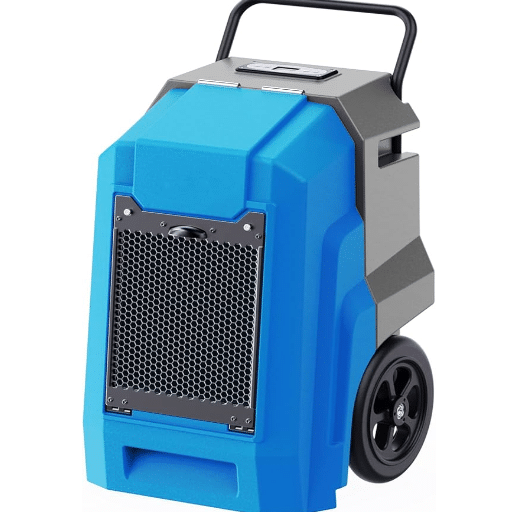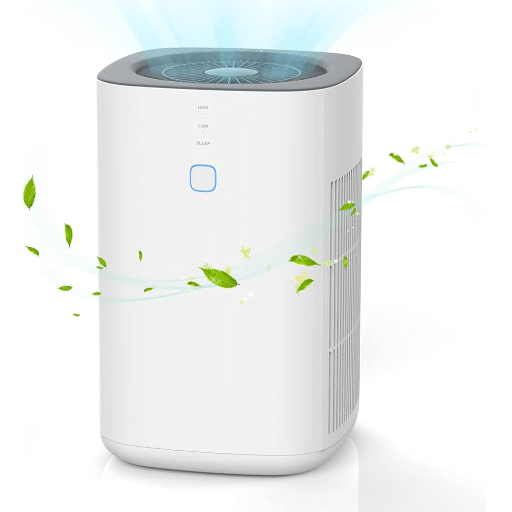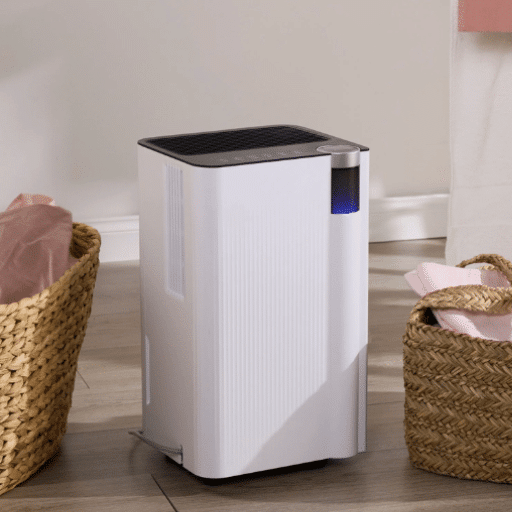Incorporating a whole-house dehumidifier with ducts attached is, without a doubt, the most fuel-efficient option for controlling humidity in a house. This guide is intended to give readers an idea of the practicalities of such installations and the most important topics, such as how the systems should be positioned and where the ducts and power connections must be fixed. The information presented here targets house owners who wish to improve air quality at home and HVAC contractors sharpening their skills. With the proper knowledge of these unfortunate events of over condensation, mold, and even destruction of indoor materials, users can counter or even prevent such tragic events from happening.
What is a ducted dehumidifier, and why do I need one?
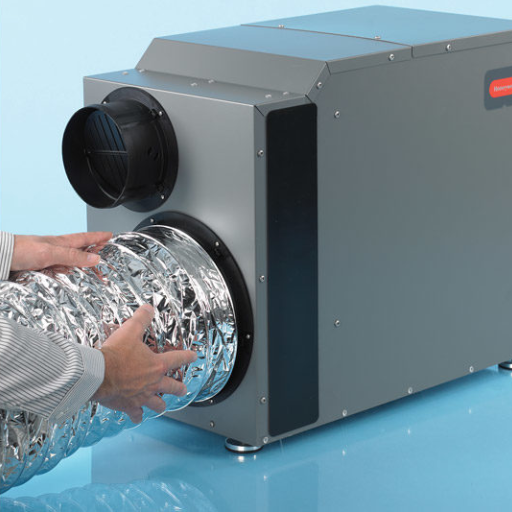
A ducted dehumidifier is a sophisticated component of HVAC technology that works to lower the water content in a given building by being directly connected to the ceiling ducts of the building. A ducted dehumidifier draws in humid air from the surroundings and then cools it down, extracting the moisture before releasing dry air back into the space. This type of dehumidifier is especially suitable for homes since it can easily control high levels of humidity, which can help prevent mold, condensation, and other issues such as poor air quality. A ducted dehumidifier aids in maintaining the structural integrity of the home and, at the same time, makes the home far more comfortable and energy efficient.
Understanding whole-house dehumidifiers and their benefits
Central systems operations that need to be installed throughout the house are called whole-house dehumidifiers. Their change to use is without complications since it is possible to connect them with the already configured HVAC systems to work autonomously separately. Whole-house dehumidifiers allow for reduced energy use, increased setting customization, and better moisture extraction. They offer a considerable advantage over portable ones because their ability to control high moisture levels makes them more suitable for working in lingering humidity environments.
A whole-house dehumidifier is beneficial in many ways. They can reduce indoor air pollutants such as dust mites and avert mold growth, resulting in healthier air. Furthermore, consistent humidity levels help prevent wooden furniture, flooring, and structural components from swelling and rotting. These systems also save energy by relieving excessive humidity in air conditioning units and reducing energy use. A whole-house dehumidifier improves comfort, protects property, and enables a healthy living environment. These machines, however, are expensive.
Signs that you need a ducted dehumidifier in your home
There are some reasons why a ducted dehumidifier may be necessary. For instance, if the indoor humidity consistently exceeds fifty percent, it creates a high probability of me encountering issues such as musty odors, mold growth, or condensation on windows. These factors can impair comfort and the quality of indoor air. I have also noted that excessive humidity can appear to warp wood, peel paint, and damage the structure, typically in areas such as the basement or crawl space. In addition, if the HVAC system cannot provide sufficient cooling or heating with the desired airflow, installing a ducted dehumidifier may be worth installing to reduce the moisture load and the strain on the cooling system. Eventually, signs like these point to adopting a holistic approach to creating a more comfortable and efficient house.
How ducted dehumidifiers improve indoor air quality
Ducted dehumidifiers maintain indoor air quality by reducing excess humidity, which helps prevent the proliferation of dust mites, mildew, and mold, all common respiratory irritants and allergens. These systems, which function along with existing HVAC systems, also ensure that all areas within a building are at an evenly balanced moisture level by consistently blowing out dehumidified and conditioned air. Furthermore, these systems ensure that the relative humidity remains between 30 percent and 50 percent, which prevents condensation on building materials and protects said materials against moisture deterioration. Many models also have advanced air filtration systems that improve air quality by capturing dust and pollen. This approach not only fosters a healthier environment for the inhabitants of the building but also boosts the energy efficiency of the HVAC system because it does not have to deal with excess strain caused by high moisture levels.
How do I choose the right ducted dehumidifier for my home?
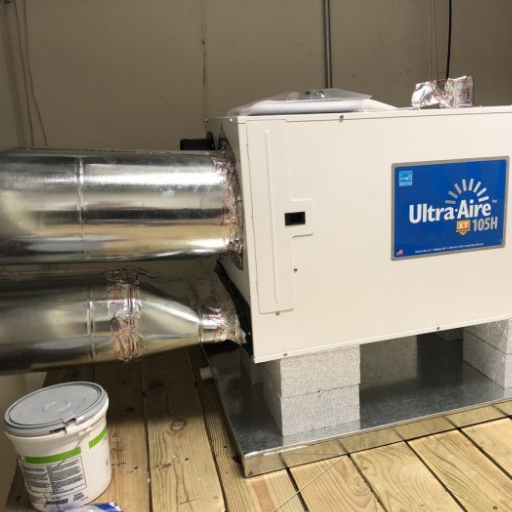
When choosing ducted dehumidifiers, several factors must be considered to enhance their effectiveness and efficiency. Start by looking at the models in your area that can measure dehumidification capacity, usually expressed in pints of humidity removed daily. This capacity should compare favorably to the size of your home and the humidity levels in your region. Then, focus on the device’s energy consumption. Search for models with the Energy Star, as these will incur lower operating costs while maintaining usable output.
An important factor is the doused dehumidifier’s compatibility with your air conditioning system. It should plug into the previously installed ductwork, and no hindrance on airflow should be experienced to avoid damaging the system. Also important is the availability of other features, such as adjustable humidity, air filters, and automated drains, that increase overall usability. Ensure that the device noise is not distracting and maintenance is not too complex for your lifestyle and comfort standards.
Finally, get these devices from trusted manufacturers who provide warranties and customer care services. Additionally, talking to a certified HVAC specialist can help you get the device built specifically for your house to help maintain proper air quality over a long period.
Factors to consider when selecting a whole-house dehumidifier
Selecting an appropriate dehumidifier for the entire house begins with energy efficiency, so I check if the appliance has an Energy Star certification or a similar badge. Subsequently, I check whether the device fits into my HVAC system. In my case, the unit should not impede the dehumidifier’s airflow. Amongst many other features, I place adjustable humidity levels, air filters, and automatic draining at the top since they are high on my convenience list and suitable for the air. Reduced noise levels when working and easy servicing are significant features that bear on comfort. Finally, I check for companies that produce reliable devices with good warranty terms and responsive customer service. I get an HVAC specialist to double-check if they are right for my house.
Sizing your ducted dehumidifier based on square footage and humidity levels
Striking a balance in the dimension of a ducted dehumidifier is essential for enhancing performance and energy efficiency. The dehumidifier’s capacity is directly related to the amount of moisture expelled from the building. First, the square footage of the place and the average indoor humidity will be investigated. For instance, units capable of removing 25 to 30 pints of moisture can function efficiently in a space of up to 1000 square feet. On the other hand, larger spaces, which are around 2500 square feet, will require units rated for 50 to 70 pints of moisture. In some cases, high humidity conditions (above 60%) or environmental conditions like basements and water intrusion areas may circumvent these general rules.
Use the sizing charts or online calculators from manufacturers, which often use these variables to offer a model best suited for your situation. Consider a zoned approach for houses with different humidity in different zones to achieve even humidity control. You must also check whether it is compatible with your HVAC systems when incorporating the dehumidifier. An HVAC professional can help you choose and install the most efficient model so you don’t waste energy or get subpar performance.
Top brands and models for ducted dehumidifiers
Aprilaire, Santa Fe, and Honeywell are the best-performing brands for ducted dehumidifiers. For instance, the Aprilaire 1850Z model is highly regarded for its sturdy construction and high output capacity with the ability to control humidity in areas as large as 5,200 square feet. Praise for Santa Fe dehumidifiers, such as the Santa Fe Advance90, stems from their power and versatility: These units can operate in the most challenging environments, e.g., a room with a basement. Honeywell whole-house dehumidifiers, particularly the Honeywell DR90A2000, are designed to integrate with HVAC systems, thus providing the best convenience for those who desire a stress-free home environment. All of these brands stand out from the competition due to the unparalleled performance they deliver.
What are the different installation options for ducted dehumidifiers?
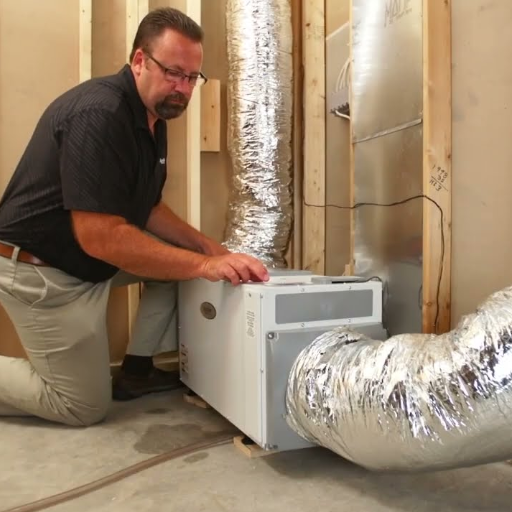
Based on the layout of the environment and the developed HVAC system, Ducted dehumidifiers can be installed in different settings. One of the most installed dehumidifiers utilizes an integration system into the central AC system, allowing for uniform air distribution in the house. Another technique applies a single return duct system dedicated to the dehumidifier to control the humidity in select rooms. Moreover, short duct freestanding setups can be installed without hassle around a single zone, for example, in the basement or crawl space. Each installation type can be tailored based on environmental needs and structural considerations to maximize moisture control.
The return-to-return installation method is explained.
The return-to-return installation method consists of installing the dehumidifier at the return air duct of the HVAC system. This means that humid air is drawn from the return duct, processed in the dehumidifier to remove the moisture, and dehumidified air is blown back into the same return duct. This technique enables effective moisture control without touching the supply side of the HVAC system, as it allows for continuous reconditioning of the air in the duct system. It is beneficial to a home or building where there is a need to reduce the system’s complexity or focus on avoiding significant ductwork changes. In most cases, the ducts must be adequately sealed to avert air loss and achieve superior functionality.
Supply-to-return installation: Pros and cons
Regarding advantages and limitations, the supply-to-return installation method has merits and demerits. On the plus side, it allows effective complete home dehumidification by using air from the supply duct, lowering water vapor concentration from all the rooms. It may also improve airflow differences and, as a result, enhance comfort without straining the HVAC system. Moreover, it is useful when controlling the supply air temperature is crucial. However, the trade-offs include careful and precise installation to eliminate airflow obstruction or pressure differential, which may reduce the system’s efficiency. Compared to return-to-return installations, these may need more complicated duct framework changes, which increases installation duration and expenditure.
Dedicated return duct installation: When and why to choose this option
On the other hand, dedicated return duct installation is appropriate when fine airflow control and optimal system performance are required. Installations of this type are valuable in controlling cross-contamination between rooms because dedicated air from certain areas is returned to the HVAC system. It is strongly recommended for houses with extensive zoning requirements, such as multi-story buildings or strict temperature-controlled spaces. Furthermore, this arrangement can enhance indoor air quality by diminishing the transfer of contaminations and allergens from one zone to another.
This option was chosen primarily because it could increase energy efficiency and improve the system’s service life. The method eliminates pressure differences and minimizes the stress imposed on the HVAC system. However, due to the complexity of their routing, these ducted systems can incur higher initial costs by installing dedicated return ducts and associated spaces. In any case, such investments are usually cost-effective in the long run and more so in cases where air quality and environmental conditions must be more stringently managed.
How do I integrate a ducted dehumidifier with my existing HVAC system?

To connect a ducted dehumidifier to your home’s HVAC framework, first, look for a device appropriate for your home’s size and dehumidification requirements. The dehumidifier must be installed after your HVAC system’s return air duct. This way, the air passes through the dehumidifier before it reaches the furnace or air handler. The installation of specific ductwork or the provision of bypass ducts may be needed to connect the system. It is recommended that a qualified HVAC engineer install all the restraints on the dehumidifier and the configuration of the thermostat or humidistat. If it is done so, optimal humidity is maintained in the indoor surroundings effortlessly without hobbling the other systems of the HVAC framework.
Connecting your dehumidifier to your home’s ductwork
A ducted dehumidifier can be fitted into your house’s ductwork by carefully placing the right unit for you and your home. First, establish if your dehumidifier will be mounted into the supply and return duct or if it requires a stand-alone unit. The air processing in the dehumidifier is done more effectively if the device is placed close to the HVAC unit. The intake port of the dehumidifier will be connected through flexible ducting to the return air duct of the HVAC device to allow the modification of humid air.
At this point, the moisture-removed air can return to the HVAC system or be sent to the area where it’s needed, whichever the design calls for. Properly securing all duct joints is also essential to avoid air leakage, which would reduce the system’s efficiency. Also, don’t forget to properly connect the unit’s condensate drain so water does not accumulate inside and start leaking.
As a best practice, coordinate the operation of the humidistat in the dehumidifier with the one in the thermostat. This way, when humidity exceeds the predetermined level, the dehumidifier will turn on automatically. In any case, respect the instructions provided and have a trained HVAC technician do the installation to make sure local codes and the characteristics of the building don’t prevent an effective system from being installed.
Balancing airflow between your HVAC and dehumidifier
I ensure both units are sized correctly to ensure proper airflow between your HVAC and dehumidifier units and calibrate for competent operation to prevent overheating. I emphasize checking the dehumidifier airflow against the HVAC return airflow to eliminate pressure differentials. In further refining air distribution, I adjust dampers or ductwork to achieve balanced airflow throughout the system. The duct connections must also be adequately sealed to prevent leakage, which is detrimental to system efficiency. Routine monitoring and maintenance of the components is essential for reliable system performance and indoor air quality.
Addressing static pressure concerns in ducted dehumidifier installations
Static pressure is directly proportional to the performance of ducted dehumidifiers because excessive pressure within the duct system can restrict air movement and diminish overall effectiveness. Additional attention must be given to static pressure measurement during system setup to determine potential issues. This uses manometers that compare and measure the supply and return ducts. Whenever the measurement for the static pressures is above normal, improvements to airflow balancing can be achieved by resizing the ducts, installing additional return air grills, or using bypass dampers to reduce restrictions. Thus, the proper dehumidifier must be procured and complemented with an appropriate HVAC system that sets external static pressure for the device. At the same time, however, outperforming filters with minimized resistance while trapping undesirable particulates will enhance system readiness. Duct checking and maintenance must be performed regularly for proper ducting and efficient operation to persist.
What are the steps involved in installing a ducted dehumidifier?
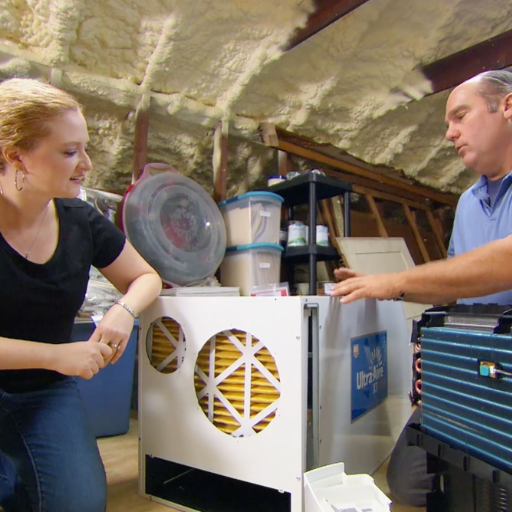
I begin by carefully selecting the unit so that I can mount the ducted dehumidifier in a preferred location. The location must also be adequate for airflow and maintenance. Next, I add the unit to the house’s existing ductwork. While doing so, I ensure these connections are tightly sealed so no airflow can escape. After all this is done, I put in the return and supply ducts and tie them to the HVAC system or build a complete duct system based on the design.
Additionally, I attached the condensate drain line to the water tank and tested its flow efficiency. To finalize, I identified the wiring, the local codes, and manufacturer instructions to determine whether to use electricity to power the unit. This was followed by a series of tests to identify the static pressure, confirm the airflow balances, and check how the dehumidifier is working with the HVAC system.
Preparing your home for dehumidifier installation
To tidy up your workspace before the setup of the dehumidifier, there are specific steps to follow to guarantee efficient performance and the system’s long life. The first step is examining the humidity level of your house to choose the capacity of the dehumidifier correctly. Employ a hygrometer to gauge humidity within problematic regions such as cavers and basements. Secondly, search for a ventilation area that is reasonable as well as assignable for system management. If the dehumidifier is ducted, this location should preferably be close to the HVAC system.
To verify the site’s electric readiness, it is crucial to examine whether an outlet or wiring is placed near the area of operation, which will assist in powering the dehumidifier. The dehumidifier unit near the floor drain, sump pump, or discharge point could provide condensate line drainage. Moreover, removing obstructive pieces near the installation site is best for proper airflow and unit functioning. Solving these issues creates a barrier-free condition for the effortless installation and efficient operations of the dehumidifier.
Common challenges and solutions during installation
- Challenge: Insufficient Drainage Options
Solution: If a floor drain or sump pump is unavailable, consider using a condensate pump to push water to a proper discharge site or reroute the drainage line to an external location. Ensure the drain lines are securely fastened to prevent leaks.
- Challenge: Electrical Compatibility Issues
Solution: Verify that the installation area has a dedicated outlet with the correct voltage and amperage as specified in the dehumidifier’s manual. If electrical wiring is inadequate, consult a licensed electrician to add an outlet or upgrade the circuit.
- Challenge: Airflow Restrictions
Solution: Ensure the area around the dehumidifier is clear of obstructions to allow sufficient air circulation. For optimal performance, maintain a minimum clearance outlined in the user manual.
- Challenge: Incorrect Humidity Settings
Solution: Monitor humidity levels with a hygrometer and calibrate the dehumidifier’s settings accordingly. Adjust the target relative humidity to industry-recommended levels, typically between 30% and 50%, depending on the climate and space.
- Challenge: Ducting Problems for Whole-House Systems
Solution: Verify that duct connections are correctly sealed using HVAC tape or clamps. If airflow is inadequate, inspect the ducts for blockages or leaks that could impede performance. A professional HVAC technician may be required for complex installations.
Understanding and addressing these potential challenges can ensure a smooth and efficient dehumidifier installation process, prolong the unit’s lifespan, and maximize its effectiveness.
How do I maintain and optimize my ducted dehumidifier system?
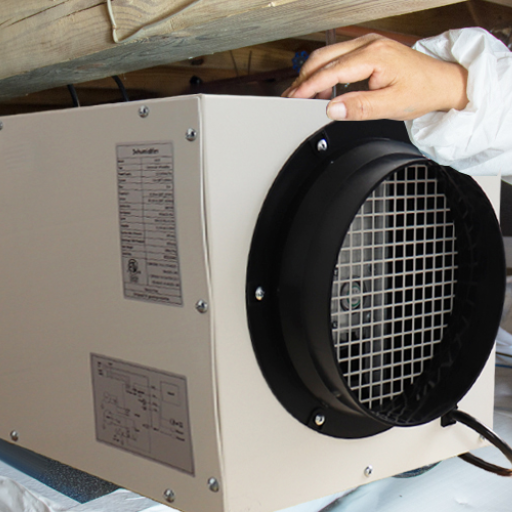
I have divided the maintenance and fine-tuning of my ducted dehumidifier into a few critical steps. Initially, I clean or change the air filters every one to three months, ensuring adequate airflow. This dramatically reduces the strain on the system. Subsequently, I examine the ductwork for leaks, blockages, or buildup and patch any gaps using HVAC tape. I устранение таких проблем активно, which prevents them from affecting the performance of the system. I also clean the condenser coils at least once a year to eliminate dust that might interfere with the dehumidifier’s performance. If clogs are found in the condensate drain, I flush them out and watch the system closely. I also make sure that there is adequate termination of water. Finally, I engage in professional maintenance of the system, scheduling my visits with the specialists once a year. The technician checks the system’s refrigerant, electrical connections, and general health and ensures everything functions correctly.
Regular maintenance tasks for your whole-house dehumidifier
I attend the following tasks to ensure my whole-house dehumidifier does not stop working. I change the air filters every two months to enhance airflow and reduce the chances of dust congregation. I check and clean the ductwork regularly, which helps in preventing air blockage and leakage. Ensure no clogs or buildup happens to the coils, and condense the drain by cleaning it once every year. These are the first few steps. I then hire professionals once every 12 months to service the system, checking the refrigerant levels, electrical components, and general system health. Following these procedures assists the system inefficiently functioning and enhances the quality of air indoors.
Optimizing dehumidifier settings for maximum efficiency
For better results from your dehumidifier, begin with a target humidity set at 30 to 50 percent relative humidity. This range is suitable for maintaining a healthy atmosphere that is free of molds and is comfortable. A 40 to 45 percent setting is adequate in moderately cold areas, while warm regions need a 30 to 35 percent setting. Air circulation and moisture removal are improved by placing the dehumidifier in a central open area and not near the edges of walls or corners, which can restrict air movement. Continuous mode should be relied on less than the humidistat feature, which activates the unit only when needed, as the first uses more energy. Hold to the manufacturer’s recommendations on servicing air filters, as this helps with their efficiency. Remember to regularly empty the condensate drain or collection tank to stop overflow. Close doors and windows while the dehumidifier is active to maintain the indoor conditions. With a follow-up of these tips, you can increase the lifecycle of the dehumidifier and its energy efficiency.
Troubleshooting common ducted dehumidifier issues
One of the nightmares ducted dehumidifiers users face is the lack of moisture elimination. In the first step, I would verify that the humidistat settings are appropriate for the set indoor humidity level. If the unit is still on standby, I would examine the air filters and check for a blockage because dusty filters can hinder airflow and diminish effectiveness. Another typical issue is piped leaking water, usually due to a blocked condensate pipe or an overwhelmed collection tank. This is generally fixed by clearing the drain line and making an effort to empty the tank frequently. Finally, if the unit is not turning on, I would check for a connection and circuit starter to see if the problem is from the power supply. Working Cooperatively, I can fix the dehumidifier because these factors must be treated.
Are there any alternatives to ducted dehumidifier installation?
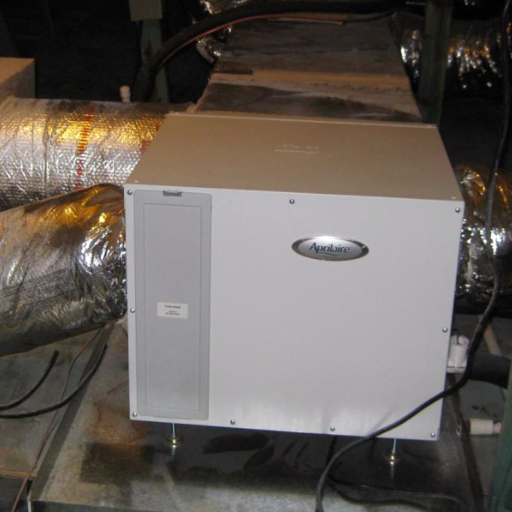
When it comes to installing ducted dehumidifiers, specific alternatives exist regarding the particular peculiarities of the space. Localized portable dehumidifiers are a practical and affordable option that is easier to achieve as they only require moisture control in compact Loos. Other possible solutions are energy recovery ventilators and heat recovery ventilators since they also assist in controlling humidity while enhancing ventilation for spaces that need moisture control and fresh air exchange. On the other hand, desiccant dehumidifiers and natural ventilation via windows and extraction fans offer a more passive approach to moisture control in areas with median humidity problems. However, these would be less effective as the moisture level is moderately high.
Comparing ducted vs. standalone dehumidifiers
The foremost considerations when choosing between duct and standalone dehumidifiers are the level of detail and the extent of the space’s humidity control measures. A ducted dehumidifier is installed directly onto the building’s HVAC system. This type of dehumidifier is perfect for large spaces or buildings with numerous areas that require moisture control because it offers collaboration and a consistent humidity balance between several rooms. These systems are most suited for whole-house and high-demand dehumidification applications; however, they come with higher installation costs and require more professional installation and maintenance.
Portable dehumidifiers, which are self-contained, are more straightforward to install and operate and require no elaborate integration. They offer cost savings that other methods lack, allowing for targeted dehumidifying in specific areas, making them ideal for small spaces or areas of concern. However, these standalone units may be insufficient in dealing with more expansive or severe humidity cases compared to the efficiency and capacity of ducted systems. In addition, these systems usually require manual emptying of their water reservoirs, leading to more frequent maintenance.
On the other hand, a ducted dehumidifier has increased power and works more efficiently with an existing HVAC system, making it suitable for long-term plans. Dehumidifiers with standalone units are more effective for confined spaces due to their lower price and ease of use. Ultimately, the plan for dealing with humidity and the budget determine the final decision.
Exploring other humidity control methods for your home
Effortlessly, the range for fostering moisture control solutions leads me to consider other strategies, such as humidity exhaust fans for the bathroom and kitchen. The exhausted air controls bathroom odors and is a great kitchen aid for cooking. I believe that the HVAC system has proven useful. The framework, especially matched with the filters, allows proper air circulation while maintaining the desired humidity. In the same breath, the ventilation supported in the house’s framework ensures that no stale air can settle in. To tackle these problem areas conveniently and without electricity, one can simply use silica or other forms of desiccants, which serve as excellent low-cost solutions to water absorption. Overall, all these measures need to be paired with an adequate dehumidifier to foster an inhabitable balance, as I have come to find out that always proves helpful.
When to consider professional HVAC solutions for humidity problems
Ignoring the air conditioning and humidity issues is unwise since one could invite excess indoor moisture, mold formation, or even condensation on window surfaces. Suppose you find yourself plagued with these signs. In that case, it is highly recommended to consider professional HVAC support and replace your aging system, which seems incapable of controlling condensation buildups. In addition, if there are certain rooms with extremely high humidity allocation, working on the dehumidifiers seems to add to the high energy costs of trying to mask the problem, too. All these signs enable the technicians to estimate the work scope required accurately. Professional guidance will surely guarantee optimal indoor air quality by installing other air conditioning system parts, such as whole-house dehumidifiers.
References
Heating, ventilation, and air conditioning
Frequently Asked Questions (FAQ)
Q: What is a whole house dehumidifier and why might I need one?
A: A whole-house dehumidifier is designed to remove excess moisture from the air throughout your home. You might need one if you are experiencing high humidity levels, which can lead to mold growth, musty odors, and discomfort. Whole-house dehumidifiers are particularly useful when your air conditioner isn’t running as frequently to remove moisture in humid climates or shoulder seasons.
Q: How does a whole-house dehumidifier integrate with my existing HVAC system?
A: A whole-house dehumidifier can be integrated into your existing duct system in several ways. The most common methods include installing it on the return side of your HVAC system, adding it to the supply plenum, or using a dedicated return duct. The installation method depends on your HVAC setup and chosen dehumidifier model.
Q: What are the benefits of ducting a dehumidifier into my HVAC system?
A: Ducting a dehumidifier into your HVAC system offers several advantages. It allows for more efficient moisture removal throughout the house, improves overall air quality, and can help reduce the load on your air conditioner. Additionally, it can help maintain a consistent relative humidity (RH) level, which is beneficial for both comfort and home preservation.
Q: How does a whole house dehumidifier differ from my air conditioner regarding moisture removal?
A: While air conditioners and dehumidifiers remove moisture from the air, whole-house dehumidifiers are specifically designed to handle latent heat (moisture) more efficiently. Air conditioners primarily focus on sensible heat (temperature) and may not effectively control humidity during milder weather. A dehumidifier can operate independently of your AC system, providing dry air even when cooling isn’t needed.
Q: What considerations should I consider when installing a whole-house dehumidifier?
A: When installing a whole-house dehumidifier, consider factors such as the size of your home, your climate, and your existing HVAC setup. Ensure proper unit sizing, plan for adequate airflow, and choose an installation location for easy maintenance. Integrating it with leak-free duct systems is crucial to maximize efficiency and effectiveness.
Q: Can a whole-house dehumidifier be used with a heat pump system?
A: A whole-house dehumidifier can be used effectively with a heat pump system. It can be particularly beneficial when the heat pump struggles with humidity control, such as during mild, humid weather. The dehumidifier can help manage moisture levels independently of the heat pump’s operation, ensuring consistent comfort and efficiency.
Q: How does the “return to supply” method work when installing a whole-house dehumidifier?
A: The “return to supply” method involves drawing air from the return duct, passing it through the dehumidifier, and feeding the dried air back into the plenum. This approach ensures the dehumidified air is evenly distributed throughout the house via the existing duct system. It’s an efficient way to install a whole-house dehumidifier and often requires minimal modifications to your existing HVAC setup.
Q: What role does building science play in whole-house dehumidifier installation?
A: Building science is crucial in whole-house dehumidifier installation, as it helps determine the unit’s most effective placement and integration. Understanding factors such as airflow patterns, thermal envelopes, and moisture sources within the home allows for optimal dehumidifier performance. Correctly applying building science principles can lead to more efficient moisture control and improved indoor air quality.
Q: How can I determine if I need a dehumidifier in addition to my air conditioning system?
A: You may need a dehumidifier if you notice persistent high humidity levels (above 50-60% RH), musty odors, or condensation on windows even when your AC is running. Other signs include mold growth, warped wood, or feeling clammy despite comfortable temperatures. In many cases, homes in humid climates or with high indoor moisture sources benefit from a dedicated dehumidification system to supplement the AC.
Q: What maintenance is required for a whole-house dehumidifier?
A: Maintenance for a whole house dehumidifier typically includes regular filter cleaning or replacement, checking and cleaning the condensate drain line, and occasional cleaning of the evaporator coils. It’s also essential to ensure proper airflow by keeping vents and returns clear of obstructions. Following the manufacturer’s maintenance instructions and scheduling annual professional inspections can help keep your dehumidifier running efficiently for years.

